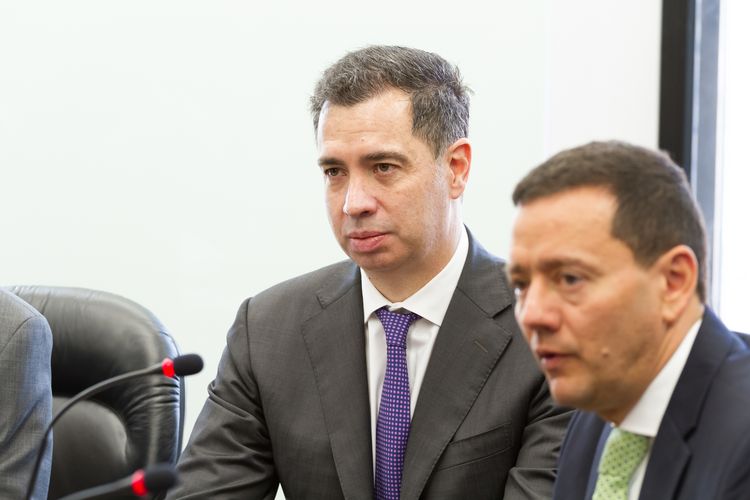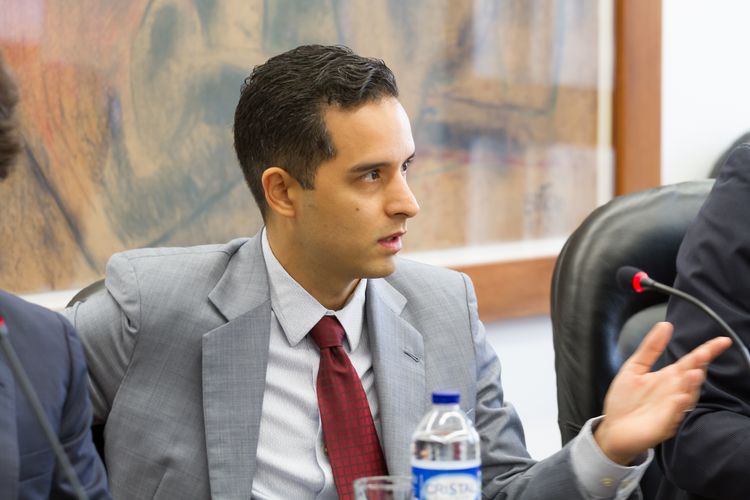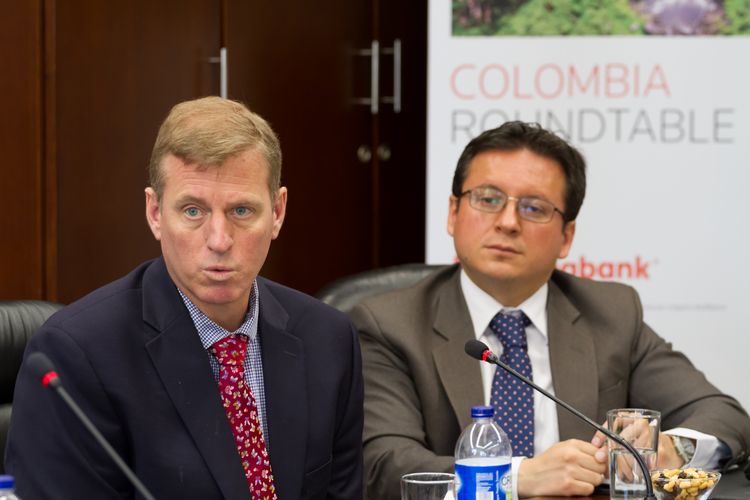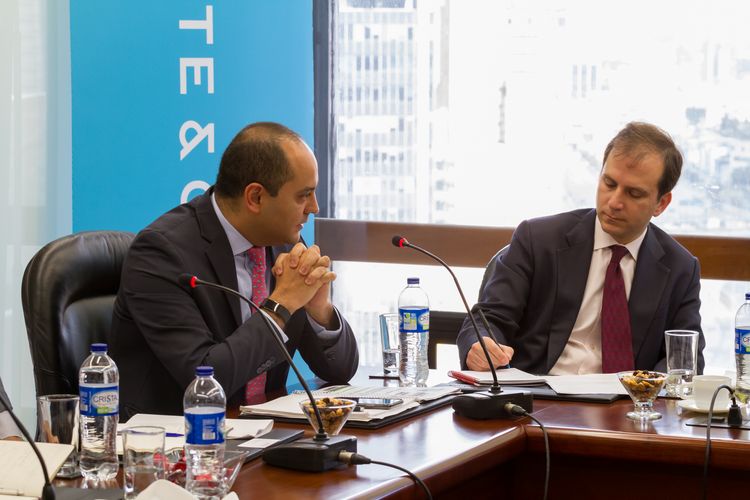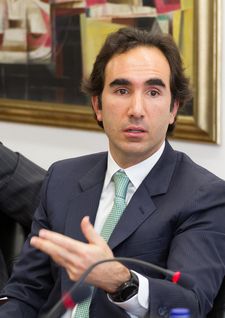IFR: Welcome everyone to IFR’s first Colombia Capital Markets Roundtable. Investors have grown more optimistic about the prospects for Colombia – at least in the short term. Right-wing candidate Iván Duque won the presidency last year, putting market fears of a leftist victory to bed, and economic growth looks set to resume this year.
Even so, challenges remain. The passage of a watered-down tax bill has given the new government some breathing space, but it fell short of mending the longer-term fiscal picture in a country rated Baa2/BBB-/BBB by Moody’s, S&P and Fitch. Richard, how does the current situation impact the outlook for the country’s ratings?
Richard Francis, Fitch Ratings: In 2016 we changed the outlook on Colombia to negative. It was a pretty bad time. The current deficit was reaching 6% of GDP, inflation was 9%, the fiscal deficit at the central government level was 4% of GDP, but we changed the outlook to stable in March 2017 because the adjustment was much stronger and more rapid than we were expecting.
The current account was adjusting quite rapidly, which was important. The deficit was still relatively high but it was coming down, and while debt was on an upward trajectory, it was more stable. Since that time, we have had a stable outlook. We are expecting growth to be 3.3% this year. I would say given where we are now I see three risks:
One is the government passed the financing law last year, which is helpful in the near term. It basically yields 0.7% of GDP in extra revenues in 2019. But because of the corporate tax cut, and the incentives for the corporate sector, we see revenues actually coming back down next year.
That leaves what we would estimate to be an approximately 1% of GDP hole to fill starting in 2020 and that hole only gets bigger every year.
The government seems to be maintaining the fiscal rule, which is quite important. The plan is to make up the extra revenues starting next year and even this year partly from privatisations, which is fine. It is a way of filling that gap. But privatisations are a one-off. You can’t keep selling assets every year for ever. So we see that as a risk on the fiscal side.
We do see growth picking back up to 3.3%. They are facing headwinds from the rise in global interest rates, trade issues with China, and lower global liquidity. And we have questions on the 4G (infrastructure projects). There are a variety of issues with the infrastructure projects, the road projects more specifically. It appears they are overcoming some of those, but we don’t see it as a motor of growth. We don’t see it distracting from growth either. We see it as pretty steady.
But the hope was there would be a spike in investment specifically coming from 4G that would lead to higher growth. The central bank has just cut its forecast to 3.4% and the government has increased theirs to 3.5% or 3.6%. But those are still higher than what we have.
The jury is still out. It remains to be seen what the outlook for growth is.
The third risk that has come up more recently is on the external front. When we moved the outlook back to stable, the current account adjustment was much more rapid and stronger than we were expecting. We were looking for a current account deficit of around 3.2% last year. But it appears from the quarterly and monthly numbers that it will be higher. I guess the central bank is saying 3.7% of GDP and are looking at a deterioration in 2019 to 3.9%. It is going in the opposite direction.
As a caveat, I would say we still expect much of that to be covered by foreign direct investment. That is important, but if you look at the debt numbers they were starting to peak and are coming down, but that trend could start to reverse.
We maintain the stable outlook but we give a lot of weight to the credibility of the government, not just on fiscal and monetary policy, but also on the changes we saw at state-controlled oil firm Ecopetrol, which were quite dramatic.
Obviously the short fall in the oil prices really hit Ecopetrol strongly. And the adjustment we saw at Ecopetrol, which involved reducing the costs and eliminating higher-cost fields has resulted in a major turnaround at Ecopetrol. We recognise that.
IFR: How about the fiscal rule?
Richard Francis, Fitch Ratings: The fiscal rule is quite important for us and we have to see how
they meet those targets. The targets just keep on getting more difficult every year but this year is the biggest adjustment, going from 3.1% of GDP to 2.4% of GDP. As we mentioned the financing law can make up that gap and the government has announced spending freezes across the board to meet that target. We think they can meet the target this year.
IFR: When will Fitch announce more on Colombia’s rating?Richard Francis, Fitch Ratings: The idea is that it will come in April. We are on a six-month cycle. We have a review twice a year. Last year was May and November and so it is likely to be the same. IFR: César, how are you going to achieve your fiscal targets this year and what have you been telling investors?
César Arias, Colombia’s Ministry of Finance: I share Richard’s opinion, because it signals what really happened in Colombia. Colombia reached a point in the downturn when all the indicators were pointing in the wrong direction, as Richard mentioned. At that point, I think a negative outlook was warranted.
But I also recognise what Fitch Ratings did in moving Colombia from a negative outlook to a stable outlook and reaffirming the ratings at BBB, which is two notches above sub-investment grade, and Fitch actually reaffirmed this on November 14 last year.
The theory of ratings will tell you that the probability that a rating action, either positive or negative, will happen over the next 18-24 months is very small, unless something extraordinary happens.
The big picture in terms of the fiscal situation is that Colombia is shifting from a world of primary fiscal deficits to primary fiscal surpluses, which is positive for public debt dynamics. And these are not expectations. This is already reflected in the data.
If you look at the fiscal results that we presented last year, we ended the year meeting the fiscal target of 3.1% of GDP and with a primary deficit of 0.3% of GDP. So 0.3 percentage point and we are already in a fiscal balance.
If what Fitch Ratings is saying is right – that we are going to be able to meet our fiscal target in 2019 of 2.4% of GDP - then we are going to have a primary fiscal surplus of 0.6% of GDP.
The cushion this government will build in the first year of this administration in a good scenario can be used to start bringing debt down gradually. Or in a more conservative scenario we can use it to absorb shocks either domestic or external without comprising the projected trajectory of debt.
In the worst-case scenario you will have flat or stable debt dynamics.
We have returned to primary fiscal surpluses after six years. And the minister of finance that has been able to accomplish more primary fiscal surpluses in Colombia’s history was Alberto Carrasquilla. We have brought debt down before when Carrasquilla was minister of finance (between 2003-2007).
In our first year in office we are already going to be able to report a primary fiscal surplus that will bring debt to a stable or even a decreasing path, and I think that is a positive message for the markets.
That was recognised in the bond issue we did in the external markets three weeks ago when Colombia went to the market right after two other Triple B sovereigns from the region issued bonds.
We issued a 10-year bond at 170bp above US Treasuries. Uruguay issued at 175bp, and they
are BBB-. But more importantly, Mexico issued at 185bp, 15bp above us and they have a better rating (A3/BBB+/BBB+). I think this is key a message that we are sending on debt sustainability. Ratings are a priority for the minister of finance and for the president.
IFR: How will you meet those fiscal targets?
César Arias, Colombia’s Ministry of Finance: On the revenue side, we have three main things: First we have a tax reform that will yield 0.7% of GDP in fresh revenue, although we have some offsetting measures like the tax cuts that are going to yield only 0.4% net this year.
But for the medium term, a key component is replenishing and broadening the tax base. In certain years it could be through tax reform because, by the way – and this is a message we are sending – we believe in incremental change on taxes.
The idea that a country has to carry out a structural tax reform to collect 1.4% of GDP in a single year is difficult to apply in practice, but if you ask me can Colombia gradually move its tax base up, I would tell you yes.
That’s because we have a track record. In the last 20 years we have done 10 tax reforms. I have looked at the international experience. We are now members of the Organisation for Economic Co-operation and Development and we have seen that is the way tax policy is being made in the developed world. You have a fiscal challenge and you address it with a fiscal response.
On top of that we were very honest in the financing plan and we expect the tax codes to bring growth up and the DIAN, our tax collection agency, to be more efficient. But we were honest and we didn’t factor them in front-loading. We only put in 0.2% of GDP from efficiency gains, stricter compliance and dynamic scoring.
But we are back-loading them. If you look at our fiscal framework in 2021 and 2022, it is more ambitious. Time will tell.
The second line is that we are forecasting a medium price of oil of US$65 for Brent. The central bank is saying US$63. Market consensus is somewhere around that. If that is true, as a base case, that means 1% of GDP in terms of income from oil through a combination of dividends and taxes.
And thirdly, we have been seeing a potential pool of assets that could be divested of around 2% of GDP, so what Richard calls a “one-off” we call a “four-offs”.
During the course of this administration we are going to have a divestment strategy that goes beyond one company and one name. It forces us to think as a state in which sectors we want to be.
IFR: Can you tell us which assets you are targeting for sale?
César Arias, Colombia’s Ministry of Finance: No I can’t. I can only tell you what the ministry of finance announced publicly. For example, we have legal authorisation to capitalise our 8.9% stake in Ecopetrol. We have done it in the past. We have used that authorisation to sell stakes twice, once in 2005 and the other in 2011. And guess who was the minister of finance at that point? Minister Carrasquilla. I know there is healthy scepticism, but we have done it, and the person who carried it out last time is again at the helm of the ministry of finance.
I can also tell you that everything is on the table. We have a three-fold strategy in revenues.
In expenditures what we are going to do is to make a strong effort to keep our expenditures constant as a percentage of GDP, especially our current expenditures. You might say we are not bringing them down. But just by the deflator it is strong effort, especially as a lot of these current expenditures are tied to laws, wages and pensions.
Right after we announced that Congress only approved half of the tax reform yield that we wanted, we decreed a freeze of Ps14trn (US$4.5bn) in the budget. We plan to translate that into budget cuts. How much of that Ps14trn will be liberated at the end is a tricky question. At the very least I would tell you something between 0.4% and 0.7% of GDP because that is the shortfall we have.
We are being more ambitious than that but budget cuts can’t be done by decree only. You have to do a line-by-line revision, institution by institution, telling them you if you are going to put a project forward, you take one back. And by June, we are going to report how much of that we are going to cut.
Public investment is chronically low. We are keeping it at somewhere like 1.5% of GDP, which is relatively low compared to previous years. But to offset that impact in investments, we are moving public investment from the central government to the regional governments. While Colombia has a tight fiscal situation at the central government level, it is very comfortable in fiscal terms at the general government level.
What we are saying is the central government is probably not going to build new roads. But we are going to put all our efforts in helping development bank Financiera de Desarrolloe Nacional (FDN) to finish what we have already committed to, the 32 projects in the 4G programme.
And we will spend our four years making sure that the infrastructure pipeline is materialised and financed.
But the tertiary roles will happen in the regions that are flush with resources and that have the capacity to execute. That is the strategy to meet the targets over the next four years.
IFR: With infrastructure arguably providing less of a boost to growth, what other sectors might lift economic activity this year and next?
Joe Kogan, Scotiabank: One sector I would love to see push growth but so far hasn’t is manufacturing. You had a dramatic depreciation in the peso back in 2014, which should have made the country more competitive and you had a number of factors that prevented manufacturing from picking up.
There were trade relations with Ecuador and Venezuela that were deteriorating and taking away some of that growth potential. And then another factor was the time required to open markets. It just doesn’t turn back on immediately when the currency depreciates.
Infrastructure is one of the things that can help bring about manufacturing and make it easier. But the Atlantic coast is growing because of the lack of infrastructure. Some manufacturing is moving to the coast because from there they can do quite well. That is an area that has been largely untapped and there has been some upside, especially if the situation with Venezuela resolves itself.
I have been fairly pessimistic about the situation in Venezuela for the last couple of years. It seemed like it could go on forever. But now you have this incredible coordinated effort among the US, the UK, South American countries with a bunch of measures to change things. If that happens Venezuela presumably will start importing again and will have the funds to do it.
That is one of the areas where I think there could be a lot of upside if things develop well.
To see the digital version of this roundtable, please click here
To purchase printed copies or a PDF of this report, please email gloria.balbastro@refinitiv.com
